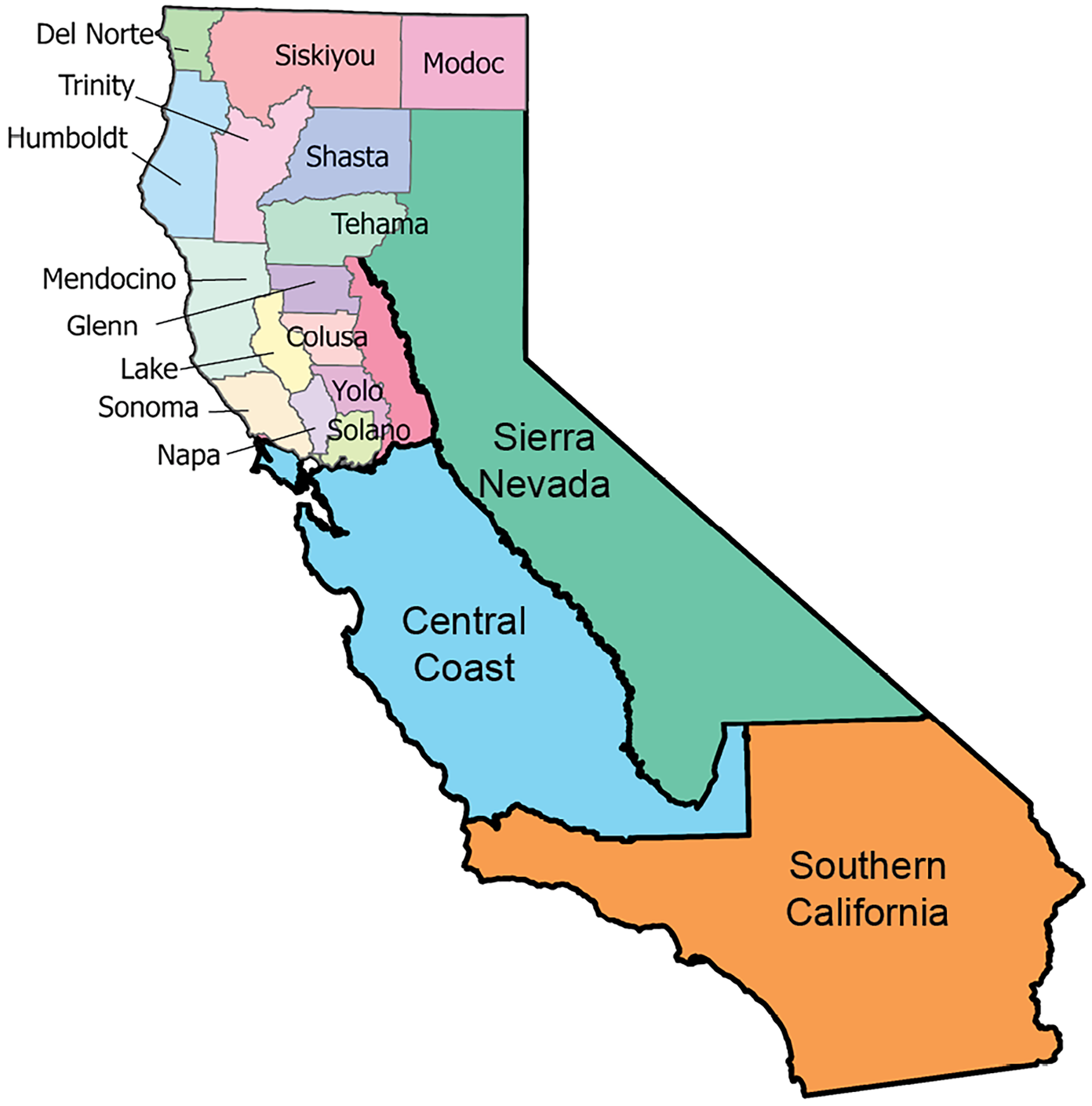Northern CaliforniaRegional Profile
About Northern California
The Northern California region stretches from the rugged coastline of the North Coast in the west with its remnants of ancient forests to the northern Sacramento Valley in the east with its valuable agricultural resources. It is home to nearly two million people that are spread over 15 primarily rural counties. Land in the northernmost counties is sparsely populated with remote communities and large areas managed by federal agencies, while forest parcels in the southern counties are owned by many small private landowners and face some of the same development pressures of the San Francisco Bay Area that these counties border. The region is also home to over thirty federally-recognized Tribes. This vast area encompasses significant ecological diversity shaped by topography coupled with a coastal climatic gradient, as well as by a long history of human land use.
Ecosystems across the region evolved to be adapted to fire from both lightning ignitions and over 13,000 years of cultural burning by Indigenous peoples. However, over a century of fire suppression and other land use changes have altered natural disturbance regimes. This is now being compounded by climate change and other novel disturbances, such as invasive species and pathogens, which are leading ecosystems to shift to new states and habitat types. This has also increased the threat of catastrophic wildfire across the region.
Many stakeholders in Northern California believe that there is a common misconception that their area is not as vulnerable to wildfire as other parts of the state. In fact, almost 70% of Lake County has burned since 2015. Trinity County is one of the highest fire risk counties in the state, and every community in the county has been evacuated at least once in the last five years. More populated areas, such as Sonoma County, have also been affected. In 2017, the Tubbs Fire took nine lives and destroyed over 3,000 homes in the city of Santa Rosa alone. Some other counties in the drier interior of the region have similarly been disproportionately affected relative to other parts of the state, while moister coastal areas are also beginning to experience more severe fire events.
The rural nature of Northern California means that many regional economies, such as timber, ranching, agriculture, and tourism, depend on land and natural resources that are increasingly threatened by wildfire. However, there is also a strong tradition of land stewardship and self-reliance in the region. These cultural values and place-based knowledge have made community-based initiatives to respond to increasing wildfire danger particularly effective in many parts of the region.
One challenge is bridging the diverse land stewardship perspectives that coexist in the region. There are many families in the region who have stewarded land for generations for ranching and timber production. Beginning in the 1960s, a countercultural back-to-the-land movement led to an influx of new residents building homesteads in remote areas and bringing with them an ethos of environmental preservation. These two traditions of land stewardship have historically been at odds, most notably during the ‘timber wars’ of the 1980s and 90s when loggers and conservationists bitterly conflicted over the management of Pacific Northwest forests. This legacy has contributed to persistent distrust of forest management in the Northern California region. Also, Tribal communities in the region are endeavoring to restore traditional land management practices that were suppressed by 19th century Euro-American settlement and 20th century fire suppression policies. These practices are embedded in a worldview of humans as kin with the natural world, which can be difficult to reconcile with the anthropocentric worldview that dominates land management work for fuels reduction.
Given this varied cultural context, it is unsurprising that one topic that was frequently raised by interviewees participating in this Northern California Regional Profile project was ‘social license.’ Whether or not vegetation treatments and other wildfire resilience-related projects had the support of local community members and other stakeholders has critically influenced whether planned projects are successful in this region. Despite these challenges, there are also many examples across the region of individuals and groups that have been highly effective in bridging historic divides to build new, stronger collaborations. New organizations, such as fire safe councils and prescribed burn associations, as well as larger landscape-scale collaboratives are forming across the region. There are also a growing number of partnerships between Tribal communities and public and private organizations that are creating more opportunities for integrating Indigenous stewardship practices into land management. In some cases, the mounting threat of wildfire has provided momentum to build consensus between diverse stakeholders and motivated community members to take an active role in increasing ecological and community resilience to wildfire.

